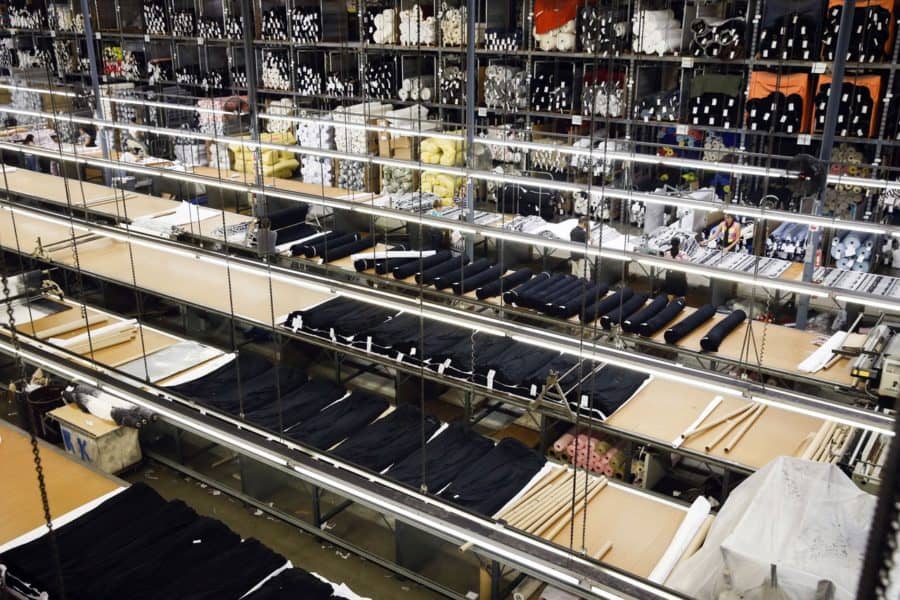May 27, 2019
Proposed Tariffs on Chinese Goods Has the Apparel Industry Scrambling

Robert Jungmann has been importing hemp fabric from China for more than 20 years for the T-shirts he manufactures in Los Angeles.
The news that the Trump administration is raising tariffs on Chinese textile imports from 10 percent to 25 percent on top of current tariffs is a big blow to his Jungmaven label.
“This tariff affects us hugely,” he said. “Our No. 1 expense is the cost of goods, and now it went up an additional 25 percent. That hurts.”
Other manufacturers faced with the Chinese textile tariff can shift their sourcing to other parts of the world, but Jungmann has a different problem. The only country that manufactures hemp fabric is China.
“There is no place we can purchase hemp fabric. We can’t purchase it from Europe, Vietnam or the United States. Only China does what we purchase. There is no option,” he said. He could switch to another fabric, but hemp has been the company’s calling card ever since he started making hemp T-shirts in 1996. He now cuts and sews about 1,500 to 2,000 men’s and women’s T-shirts a week.
Jungmann said he will have to restructure his prices and factor in this additional tariff increase, which goes into effect for all goods coming in after June 1. “I am putting together my next line sheet as we speak. We had already built in the 10 percent tariff increase but not the 25 percent,” he said.
More tariffs on top of current textile tariffs are just one part of the growing trade dilemma with China. The Trump administration is now threatening to impose up to 25 percent tariffs on just about all goods coming from China, which would include apparel and footwear as well as all apparel components, from zippers and buttons to trims and embellishments.
The effect on the U.S. retail industry as well as clothing and shoe importers would be tremendous. “Our members are freaked out,” said Steve Lamar, the executive vice president of the American Apparel & Footwear Association, whose hundreds of members encompass some of the largest importers and manufacturers in the United States. They include VF Corp., PVH Corp., Ralph Lauren Corp., Perry Ellis International Inc. and Bloomingdale’s.
“This is kind of the nuclear option that people were fearing and that the president has invoked,” Lamar added. “It really hits everybody.”
Importers were totally taken by surprise by the news because a few weeks ago President Trump was talking about a potential trade deal with China after months of trade negotiations. Now he has reversed course and is headed in the opposite direction.
Even if people are manufacturing their goods in the United States, there are certain components that are predominantly manufactured in China. Some of those are the chemicals and dyes used to treat and dye fabric.
At Swisstex California, a major dye and finishing house in Los Angeles that works with companies such as Nike and Under Armour, company owners have seen the price of Chinese chemicals and dyes jump 30 percent in the last year as tariffs and short supplies have added to pricing pressures.
“This has a dramatic impact on us,” said Keith Dartley, president of Swisstex Direct, a partner with Swisstex California. “Most of the dyes and chemicals made in the world are produced in China and India. Recently there has been a shortage of dyes and chemicals as China is shutting down a lot of the dirtier plants over there.”
While chemical prices are going up, much of the knit fabric the company uses is made in the United States or Latin America. So Swisstex California also sees an upside to the tariff situation. Maybe more companies will be manufacturing apparel in the United States and the Americas as China becomes more expensive.
Swisstex opened a factory in El Salvador after the Dominican Republic-Central American Free Trade Agreement went into effect in 2006. The complex now has a cut-and-sew factory as well as a dye-and-finishing facility that employs more than 200 people. “This could create a significant opportunity for this region because it will look more attractive for production,” Dartley said.
The new 25 percent additional tariff on textiles has Steve Barraza, owner of the womenswear manufacturer Tianello, looking for new silk sources to make the blouses and other items his 28-year-old company cuts and sews near downtown Los Angeles.
He said he is considering travelling to Thailand to check out Thai silk, which normally has no duty because silk is not made in this country.
The 25 percent tariff on Chinese silk means it will cost $5 more to manufacture a blouse, which normally uses two yards of fabric. By the time that blouse is sold in a store, it will add an additional $20 to the price tag, Barraza said.
“Maybe this will give me an opportunity to get out of my box and search for something different,” he said. On the bright side, he hopes more people will be buying his domestically made garments.
If the Trump administration does decide to impose an additional 25 percent tariff on apparel and footwear, it could take effect as early as June 25 after public comments are heard from industries affected by the tariff, said Richard Wortman, a Los Angeles customs attorney with Grunfeld, Desiderio, Lebowitz, Silverman & Klestadt.